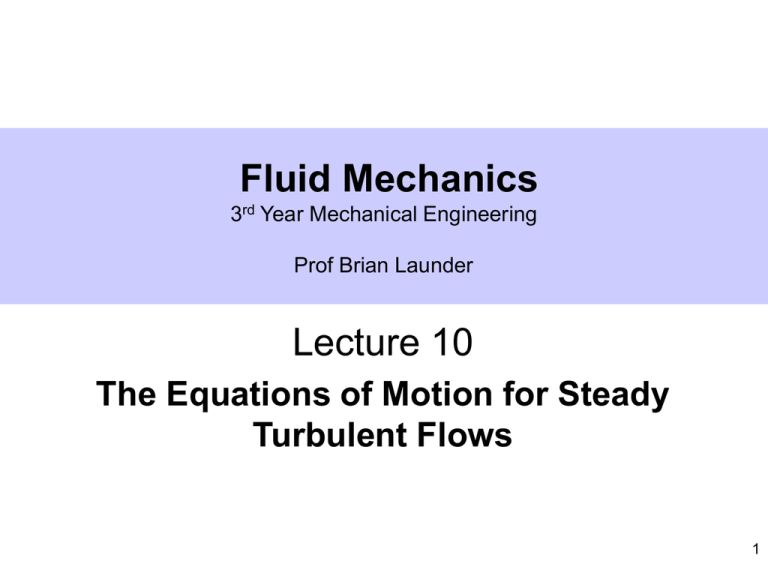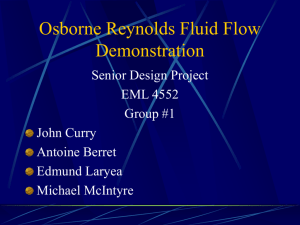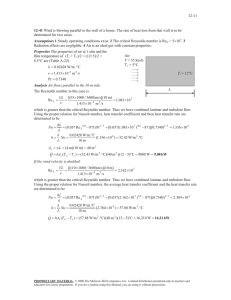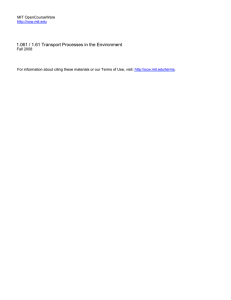Fluid Mechanics Lecture 10 The Equations of Motion for Steady Turbulent Flows
advertisement

Fluid Mechanics 3rd Year Mechanical Engineering Prof Brian Launder Lecture 10 The Equations of Motion for Steady Turbulent Flows 1 Objectives • To obtain a form of the equations of motion designed for the analysis of flows that are turbulent. • To understand the physical significance of the Reynolds stresses. • To learn some of the important differences between laminar and turbulent flows. • To understand why the turbulent kinetic energy has its peak close to the wall. 2 The strategy followed • We adopt the strategy advocated by Osborne Reynolds in which the instantaneous flow properties are decomposed into a mean and a turbulent part. (for the latter, Reynolds used the term sinuous). • We shall mainly use tensor notation for compactness. (Tensors hadn’t been invented in Reynolds’ time.) 3 Preliminaries • We consider a turbulent flow that is incompressible and which is steady so far as the mean flow is concerned. • For most practical purposes one is interested only in the mean flow properties which will be denoted U, V, W (or Ui in tensor notation). • The instantaneous total velocity has components . U , V , W (or U ) i 1 t T Ui U i dt U i • So T t • The difference between Ui and U i is denoted ui, the turbulent velocity: Ui Ui ui 1 t T ui dt 0 ui • NB the time average of ui is zero, i.e. T t 4 An important point to note • If a variable is a function of two independent variables, x and y, differential or integral operations on it with respect to x and y can be applied in any order. • Thus dy dy x x • So t T t T U U U 1 U 1 dt Udt x T x x T x x t t 5 Averaging the equations of motion • First, note that the instantaneous static pressure is likewise written as the sum of a mean and turbulent part: P P p • The time average of P / xi ( P p) / xi P / xi where the overbar denotes the time-averaging noted on the previous slide. • Treating the viscosity as constant, the time averaged value of the viscous term in the NavierStokes equations may be written: , • But: 2U i x j 2 2 (U i ui ) x j 2 2U i x j 2 U jUi (U j u j )(Ui ui ) U jUi u jui 6 The continuity equation in turbulent flow • For a uniform density flow: • But • ..or ui xi ui xi 0 …so U V 0 x y Ui xi U i xi (U i ui ) xi 0 0. • Thus, the fluctuating velocity also satisfies u v w 0 or ui xi 0 x y z 7 The averaged momentum equation • From the averaging on Slide 6: 1 P U i U j ui u j t x j xi x j x j U i U i Convection Diffusion This is known as the Reynolds Equation • Note that this is really three equations for i taking the value 1,2 and 3 in three orthogonal directions • Recall also that because the j subscript appears twice in the convection and diffusion terms, this implies summation, again for j=1,2, and 3. U i U i UPi UiU i Ui 1 • Thus: U U V W u u t j x j xi x j y x j i z j 8 Boundary Layer form of the Reynolds Equation • The form of the Reynolds equation appropriate to a steady 2D boundary layer is taken directly from the laminar form with the inclusion of the same component of turbulent and viscous stress: i.e. U U 1 dP U U V uv x y dx y y U V 0 x y • The accuracy of this boundary layer model is, for some flows, rather less than for the laminar flow case (i.e. the neglected terms are less “negligible”). 2 U U 1 dP U 2 u v U V uv x • The form: x y dx y y is a higher level of approximation. 9 Who was Osborne Reynolds? • Osborne Reynolds, born in Belfast - appointed in 1868 to the first fulltime chair of engineering in England (Owens College, Manchester) at the age of 25. • Initially explored a wide range of O phenomena: the formation physical of hailstones, the effect of rain and oil in calming waves at sea, the refraction of sound by the atmosphere… • …as well as various engineering works: the first multi-stage turbine, a laboratory-scale model of the Mersey estuary that mimicked tidal effects. 10 Entry into the details of fluid motion • By 1880 he had become fascinated by the detailed mechanics of fluid motion….. • ….especially the sudden transition between direct and sinuous flow which he found occurred when: UmD/ 2000. • Submitted ms in early 1883 – reviewed by Lord Rayleigh and Sir George Stokes and published with acclaim. Royal Society’s Royal Medal in 1888. 11 Reynolds attempts to explain behaviour • In 1894 Reynolds presented orally his theoretical ideas to the Royal Society then submitted a written version. • This paper included “Reynolds averaging”, Reynolds stresses and the first derivation of the turbulence energy equation. • But this time his ideas only published after a long battle with the referees (George Stokes and Horace Lamb – Prof of Maths, U. Manchester) 12 Some features of the Reynolds stresses • The stress tensor comprises nine elements but, since it is symmetric ( uiu j u j ui ), only six components are independent since u1u2 u2u1 etc. or in Cartesian coordinates uv vu; uw wu; vw wv. • If turbulence is isotropic all the normal stresses (components where i=j) are equal and the shear stresses ( i j ) are zero. (Why??) • The presence of mean velocity gradients (whether normal or shear) makes the turbulence nonisotropic. • Non-isotropic turbulence leads to the transport of momentum usually orders of magnitude greater than that of molecular action. 13 More features of the Reynolds stresses • Turbulent flows unaffected by walls (jets, wakes) show little if any effect of Reynolds number on their growth rate (i.e. they are independent of ). • Turbulent flows (like laminar flows) obey the noslip boundary condition at a rigid surface. This means that all the velocity fluctuations have to vanish at the wall. • So, right next to a wall we have to have a viscous sublayer where momentum transfer is by molecular action alone; uiu j 0. • The presence of this sublayer means that growth rates of turbulent boundary layers will depend on Reynolds number. 14 Comparison of laminar and turbulent boundary layers Laminar B.L. Recall: The very steep near-wall velocity gradient in a turbulent b.l. reflects the damping of turbulence as the wall is approached But why do turbulent velocity fluctuations peak so very close to the wall? 15 The mean kinetic energy equation • By multiplying each term in the Reynolds equation by Ui we create an equation for the mean kinetic energy: U U U U U P U U i t i U j i x j i i ui u j xi x j x j i i • The left side is evidently: DK 2 2 2 Ui 2 Ui 2 or, with KUi /2, t U j x j Dt • Re-organize the right hand side as: U i P xi 2 U i2 x 2j 2 2 U U i i U i ui u j ui u j x j x j x j A B C D E See next slide for physical meaning of terms 16 The “source” terms in the mean k.e eqn • A: Reversible working on fluid by pressure • B: Viscous diffusion of kinetic energy • C: Viscous dissipation of kinetic energy • D: Reversible working on fluid by turbulent stresses • E: Loss of mean kinetic energy by conversion to turbulence energy 17 A Query and a Fact • Question: How do we know that term E represents a loss of mean kinetic energy to turbulence? • Answer: Because the same term (but with an opposite sign) appears in the turbulent kinetic energy equation! • The mean and turbulent kinetic energy equations were first derived by Osborne Reynolds. 18 Boundary-layer form of mean energy equation • For a thin shear flow (U(y)) the mean k.e. equation becomes: 2 2 U dPU i DK K U uvU uv 2 Dt dx y y y y • Consider a fully developed flow where the total (i.e. viscous + turbulent) shear stress varies so slowly with y that it can be neglected. w dU uv const. dy • In this case, where does the conversion rate of kinetic energy reach a maximum? 19 Where is the conversion rate of mean energy to turbulence energy greatest? • This occurs where: d dU uv 0 dy dy d 2U dU d uv or where uv 0 2 dy dy dy d 2U dU d ( dU dy w ) uv 0 or: dy dy dy 2 d 2U dU uv 0 or, finally: 2 dy dy Thus, the turbulence energy creation rate is a maximum where the viscous and turbulent shear stresses are equal 20 The near wall peak in turbulence explained • The peak in turbulence energy occurs very close to the point where the transfer rate of mean energy to turbulence is greatest • This occurs where viscous and turbulent stresses are equal – i,e. within the viscosity affected sublayer! • Why the turbulent velocity fluctuations are so different in different directions will be examined in a later lecture. 21 Why is the normal stress perpendicular to the wall so much smaller than the other two? • Continuity for turbulent flow: u v w 0 x y z • Apply this at y =0 (the wall) • But on this plane u=w=0 for all x and z So, v y 0 at y 0 ; but u and w deriv’s w.r.t. y 0 • Expand fluctuating velocities in a series: u a1 y a2 y 2 a3 y3...; v b1 y b2 y 2 a3 y3...; w etc. But b1 must be zero (if v / y 0 at y 0. ) 2 4 So, while 2 2 2 u w y , v y • Q: How does the shear stress uv vary for small y? 22 Extra slides • The following slides provide a derivation of the kinetic energy budget from the point of view of the turbulence. • They confirm the assertion made earlier that the term uiu j Ui x j represents the energy source of turbulence. • We do not work through the slides in the lecture (Dr Craft will provide a derivation later) but the path parallels that for obtaining the mean kinetic energy. 23 The turbulence energy equation-1 • Subtract the Reynolds equation from the Navier Stokes equation for a steady turbulent flow ui t (U j u j )(U i ui ) x j • This leads to: ui t U j ui x j 2 (U i ui ) 1 ( P p) xi x 2j 2 U U u u Ui 1 P j i j i 2 x x x x j j j i uj Ui x j (uiu j uiu j ) x j 2ui 1 p xi x j 2 • Note the above makes use of u j / x j u j / x j since by continuity u j / x j 0. 24 The turbulence energy equation - 2 • Multiply the boxed equation from the previous slide by ui and time average. ui (ui u j ui u j ) ui 2ui 1 ui p U j ui u j t x j x j x j xi x j 2 ui ui • Note: ui ui ui ui t U i ui 2 / 2 t k t where k is the turbulent kinetic energy: k u 2 u 2 u 2 1 2 3 2 • The viscous term is transformed as follows: ui ui ui k u ui 2 i x j x j x j x j x j xj x j 2ui • turbulence energy dissipation rate 25 The turbulence energy equation - 3 • After collecting terms and making other minor manipulations we obtain: pui U i Dk k 2 [ui u j / 2 ij ] ui u j Dt x j x j x j viscous turbulent diffusion generation dissipation • Note this is a scalar equation and each term has to have two tensor subscripts forpueach letter. U Dk k 2 i ] u u i [ u u / 2 U / x j • Repeat Q & A: How doi we know that j ij i j i Dt x j x j x j represents the generation rate of turbulence? Ans: The same term but with opposite sign appears in the mean kinetic energy equation. 26 A question for you • Compile a sketch of the mean kinetic energy budget for fully developed laminar flow between parallel planes. 27



